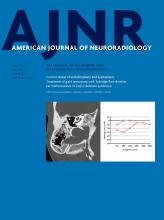Table of Contents
Perspectives
Review Article
Level 1 EBM Expedited Publication
- Parent Artery Reconstruction for Large or Giant Cerebral Aneurysms Using the Tubridge Flow Diverter: A Multicenter, Randomized, Controlled Clinical Trial (PARAT)
This was a prospective, multicenter, randomized trial conducted at 12 hospitals throughout China. Enrolled adults with unruptured large/giant intracranial aneurysms were randomly assigned (1:1) to receive either Enterprise stent-assisted coiling or Tubridge flow diverter implantation. The primary end point was complete occlusion at 6-month follow-up, while secondary end points included technical success, mortality, target vessel–related stroke, aneurysm bleeding, in-stent stenosis, parent artery occlusion, and the frequency of all adverse events. The results of 6-month follow-up imaging included complete occlusion rates of 75.34% versus 24.53% for the Tubridge and stent-assisted coiling groups, respectively. This trial showed a higher rate of large and giant aneurysm obliteration with the Tubridgeflow diverter over Enterprise stent-assisted coiling. However, this higher obliteration rate came at the cost of a nonsignificantly higher rate of complications.
General Contents
- Localized Marked Elongation of the Distal Internal Carotid Artery with or without PHACE Syndrome: Segmental Dolichoectasia of the Distal Internal Carotid Artery
Intracranial dolichoectasia of the distal ICA was identified in 20 patients from 2005–2016 through a review of diagnostic cerebral angiography results. Images were reviewed to determine the vascular morphologic dispositions around the distal ICA, including dysplasia, mural calcification, vessel wall enhancement, lumen narrowing, and aneurysm formation. In this cohort, which had a strong female predominance (male/female ratio2:18), intracranial dolichoectasia had a more ipsilateral vascular morphologic disposition. Mural calcification was detected more frequently in elderly patients, whereas vessel wall enhancement was detected more frequently in younger patients. Follow-up images showed a slow progression of the lesions. The segmental nature of the striking elongation and tortuosity of the distal ICA suggest a type of congenital lesion representing either a sporadic phenomenon or an arterial change associated with PHACE syndrome.
- Brain MRI Characteristics of Patients with Anti-N-Methyl-D-Aspartate Receptor Encephalitis and Their Associations with 2-Year Clinical Outcome
The authors enrolled 53 patients with anti-N-methyl-D-aspartate receptor encephalitis and performed 2-year follow-up. Brain MRIs were acquired for all patients at the onset phase. The brain MR imaging manifestations were classified into 4 types—type 1: normal MR imaging findings; type 2: only hippocampal lesions; type 3: lesions not involving the hippocampus; and type 4: lesions inboth the hippocampus and other brain areas. Twenty-eight (28/53, 53%) patients had normal MR imaging findings (type 1), and the others (25/53, 47%) had abnormal MRI findings—type 2: 7 patients (13%); type 3: 7 patients (13%); and type 4: 11 patients (21%). The presence of hippocampal lesions and relapse was associated with poor outcome.
- European Multicenter Study for the Evaluation of a Dual-Layer Flow-Diverting Stent for Treatment of Wide-Neck Intracranial Aneurysms: The European Flow-Redirection Intraluminal Device Study
Consecutive patients with intracranial aneurysms treated with the FRED between February 2012 and March 2015 were retrospectively reviewed. Complications and adverse events, transient and permanent morbidity, mortality, and occlusion rates were evaluated. A total of 579 aneurysms in 531 patients were treated with the FRED. Seven percent of patients were treated in the acute phase of aneurysm rupture. The median aneurysm size was 7.6 mm and the median neck size 4.5 mm. There was progressive occlusion witnessed with time, with complete occlusion in 18 (20%) aneurysms followed for up to 90 days, 141 (82.5%) for 180 days, 116 (91.3%) for 1 year, and 122 (95.3%) aneurysms followed for more than 1 year. This retrospective study in real-world patients demonstrated the safety and efficacy of the FRED for the treatment of intracranial aneurysms.
- Accuracy of CT Angiography for Differentiating Pseudo-Occlusion from True Occlusion or High-Grade Stenosis of the Extracranial ICA in Acute Ischemic Stroke: A Retrospective MR CLEAN Substudy
All patients from the Multicenter Randomized Clinical Trial of Endovascular Treatment for Acute Ischemic Stroke in the Netherlands (MR CLEAN) with an apparent ICA occlusion on CTA and available DSA images were included. Two independent observers classified CTA images as atherosclerotic cause (occlusion/high-grade stenosis), dissection, or suspected pseudo-occlusion. Pseudo-occlusion was suspected if CTA showed a gradual contrast decline located above the level of the carotid bulb, especially in the presence of an occludedintracranial ICA bifurcation (T-occlusion). In 108 of 476 patients (23%), CTA showed an apparent extracranial carotid occlusion. DSA was available in 46 of these cases, showing an atherosclerotic cause in 13 (28%), dissection in 16 (35%), and pseudo-occlusion in 17 (37%). The sensitivity for detecting pseudo-occlusion on CTA was 82% for both observers. The authors conclude that on CTA, extracranial ICA pseudo-occlusions can be differentiated from true carotid occlusions.
- Evaluation of the Normal Cochlear Second Interscalar Ridge Angle and Depth on 3D T2-Weighted Images: A Tool for the Diagnosis of Scala Communis and Incomplete Partition Type II
The second interscalar ridge notch angle and depth were measured on MR imaging in normal ears by a single experienced neuroradiologist. The images of normal ears were then randomly mixed with images of ears with incomplete partition II malformation for 2 novice evaluators to measure both the second interscalar ridge notch angle and depth in a blinded manner. For the mixed group, interobserver agreement was calculated, normal and abnormal ear measurements were compared, and receiver operating characteristic curves were generated. The 94 normal ears had a mean second interscalar ridge angle of 80.86° and depth of 0.54mm with the 98th percentile for an angle of 101° and a depth of 0.3 mm. In the mixed group, agreement between the 2 readers was excellent, with significant differences found between normal and incomplete partition type II ears for angle and depth on average. The authors conclude that a measured angle of >114° and a depth of the second interscalar ridge notch of ≤0.31 mm suggest the diagnosis of incomplete partition type II malformation and scalacommunis.








